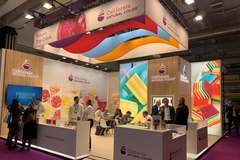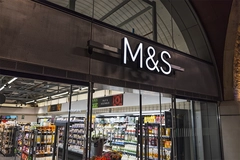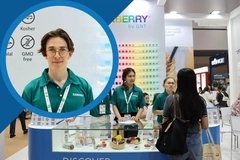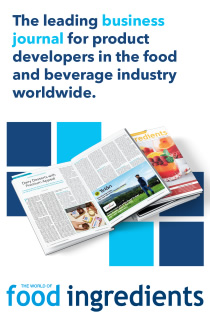
- Industry news
Industry news
- Category news
Category news
- Reports
- Key trends
- Multimedia
- Journal
- Events
- Suppliers
- Home
- Industry news
Industry news
- Category news
Category news
- Reports
- Key trends
- Multimedia
- Events
- Suppliers
ISM & ProSweets 2025 live: “Critical” consumer attitudes and evolving regulations drive GNT’s color innovations

GNT is showcasing its range of Exberry colors in potato chips with on-trend flavors and colors at the ongoing ProSweets 2025 in Cologne, Germany. The colors, formulated using non-GMO fruit, vegetables and plants, reflect the rising trend of “snackification” and consumer preference for sophisticated, diverse flavors.
The ingredients support natural ingredient declarations, elevating visual appeal in confectionery and snacks while also emphasizing transparency and consumer awareness.
Food Ingredients First catches up with Jill Janssen, head of sales (DACH, Benelux, Turkey) at GNT, to understand how the Dutch company uses natural colors to create vibrant and appealing snacks and navigates regulatory changes like the recent red dye no.3 ban.
“We still see a lot of snackification going on, so people like to try multiple things throughout the day. They not only go for three standard meals as we had before, breakfast, lunch and dinner, but like to have more occasions where they have smaller snacks,” she tells us live from the showfloor.
“They [consumers] are looking for more sophistication, beyond the standard flavors, the standard combinations that they are used to, also in relation to color. But they’re looking for more diversification, which we can offer by combining on-trend flavors in very attractive, appealing colors.”
Adding hues to potatoes
Potato chips, which are colored with GNT’s “eye-catching” Exberry range and in-demand flavors, are on display at the trade show.
Jill Janssen, head of sales (DACH, Benelux, Turkey) at GNT.“We decided to color six plain potato chips with different seasonings and colors linked to on-trend flavors. For example, the green ones are colored with the charged scallion seasoning.”
“We also developed a rainbow one, so it’s going really from green to blue to purple, and some yellowish-orange and red options are available,” notes Janssen.
“People are attracted to them because they’re looking for some on-trend flavors, but also ones that come to life via the colors.”
Rise of careful consumption
Janssen also discusses the need for market transparency as consumers increasingly scan labels and track ingredient sourcing information.
“We had a lot of critical consumers and manufacturers at our desk [at ProSweets]. So it’s not that everybody believes what is told to them or what is shared in general media. A lot of people deep dive or investigate that by themselves.”
“We see a lot of critical people becoming more aware of what they contribute, make, or consume. The critical attitude becomes increasingly fitted to clean and clear labels.”
This was evident with the snackification trend as well, she notes, adding that it is still tapping into the need for giving consumers something “special and sophisticated.”
“On the other hand, it also provides a transparent look at what is in it and what you’re consuming at the end as a consumer.”
Navigating regulations
While discussing the regulations surrounding food ingredients, Janssen says there is a lot of ongoing development on a global scale, which sometimes also involves the color business.
The upcoming ban on red dye no.3 has ramped up innovation efforts by color experts, including their use of natural solutions in their formulation.
Janssen tells us GNT also offers a clean label color alternative for consumers amid such bans.
GNT showcased potato chips with seasonings using Exberry Shade Vivid Orange and Shade Red MN powder.“Our colors are always made from fruit, vegetables, and edible plants, with our sustainable plant-based colors, which means that most of them do not have an E-number on the label.
For instance, the company has formulated a red food color in combination with its “Shade Red MN powder” made from radish, she adds. Manufacturers can choose the colors depending on the kind of application and market.
The company also has application centers in Germany, where its application specialists can help manufacturers match colors with artificial options, provide support with new product launches, and mimic a certain artificial color.
“Regarding regulatory support, we can also advise you on that, depending on the most suitable solution for your application.”
Tracking beverage footprint
Janssen says sustainability is a key focus for GNT, which recently won the EcoVadis gold medal. At ProSweets, the company also showcased a drink concept to show how Exberry colors factor into products’ carbon footprint.
“The beverage supports a low carbon footprint. This is the first product where we made the carbon footprint of a specific application available, and that’s what we try to do more now. ”
“Consumers and manufacturers can use that for their calculations into the final product. For example, we have a beverage that we call the Citrus Sunset. It has a Mandarin flavor, and the overall carbon footprint of this particular drink is 0.08 kgs of carbon dioxide, and that’s per liter, and of course, excluding the packaging and the refrigeration.”
“But this gives a good example of how Exberry can contribute to a very low carbon footprint because the color in this beverage only contributes 2.6% of the total carbon footprint of this entire product. That’s also showcasing how we can contribute to that in day-to-day practice,” she concludes.
ProSweets 2025 is taking place in Cologne from February 2-5 and is co-located with ISM.
With additional reporting by Anvisha Manral from ISM & ProSweets 2025, Cologne, Germany

















